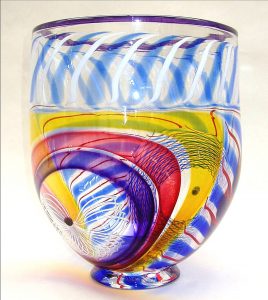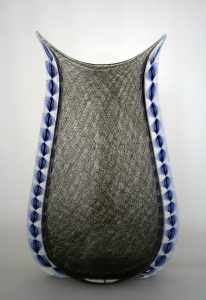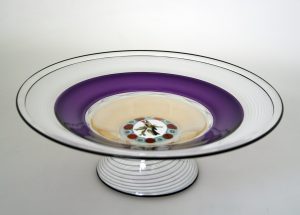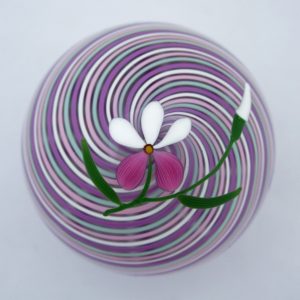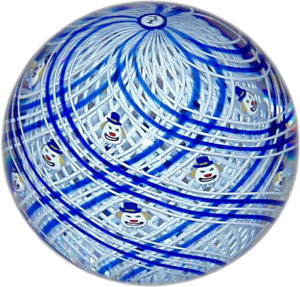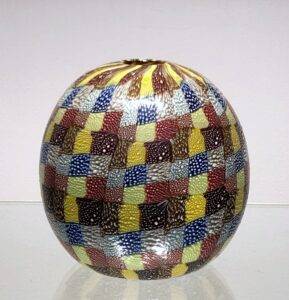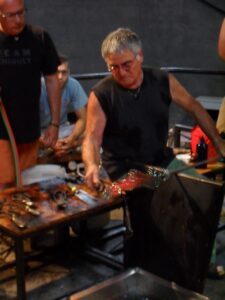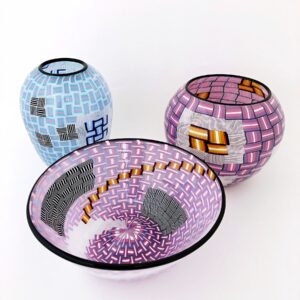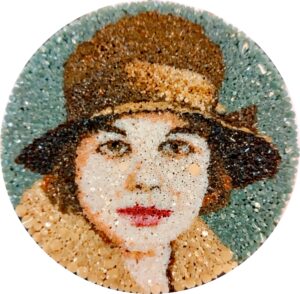Continuing from the last post, the next 25 years…
So I am now self-employed, in partnership with Sue my wife. We had found premises in Selkirk where we lived, about 1 mile down the hill towards the river.
The furnace arrived, but not before Sue had made multiple phone calls to Scottish Gas to put a new meter in that was big enough to handle the capacity of our furnace needs. Our furnaceman Mike Tuffy said he’d never seen someone pull everything together in such a short space of time, especially someone not professionally involved in the glass industry. Just as well as everything turned up to be installed shortly after. We had a bit of a problem with the kiln being delivered, other than that it all went smoothly.
The furnace was installed as well as the glory hole and iron warmer, the roofers were installing the flue at the same time so it became a bit crowded in the workshop. As all this was happening, I suddenly wondered if we were ready, there was so much that I needed to do, make a rake, weld the back and sides on the shovel for the cullet, a grabber for the rings to be made…the only thing I had welded together were the 2 chairs and marver stand, I had to get a move on! Luckily there was lots of room in the workshop at the beginning. The furnace was commissioned, the pot arched and lined, and I filled it up for the first time.
The old woollen mill unit had a huge wooden beam running across where I worked when the furnace was up and running lanolin dripped continuously from it and newspapers were lined across the floor to soak up the oil. I would come home from work with splatter marks on my T-shirt where I’d been hit by the drips.
Our first employee Peter, worked with us for a few years then went off to college to do a glass course. Stan was next, he was with us a bit longer before leaving. Both had multiple days off, so Sue took over their role as assistant. Arran, our son, was with us for about a year when a recession hit, we decided that 3 people from the same house working at the same place wasn’t a good idea so suggested he look for employment elsewhere. He had fresh ideas that worked well so it was sad that we had to let him go.
I worked on building products for “niche” markets, these varied in price ranges as well so I think we had something for everyone. I worked on my cane-making, and as I only had one making “chair” I developed the incalmo technique to work for myself. Life was one big learning curve…
I started to develop “Vetro” large blown vessels using cane making and incalmo together, then reversing the axis so the patterns were on each side when fully blown. I was really interested in how far I could push this idea, which later developed into my other designs of “Swirly” and “Patch”. But there was one cane technique that I hadn’t figured out, that was “Merletto”. In the past, I had always learnt using “trial and error” methods, where I simply thought about it, and then practiced until I found a way of making it work. With merletto, this wasn’t going to work until I worked out how those canes were made. After 4 years of thinking about it, I managed to perfect it after just 2 attempts. Merletto is my favourite cane technique to blow, however it is limiting as to what can be done with it!
All the time I was practising cane working, I had never looked at YouTube to see how, and what others were making. One I’m not interested, two I don’t want to be influenced by what I see, and three, I actually like working my brain and figuring things out. This has led me on a path of discovery to figure out how to blow glass without needing the glass-melting furnace on. This is also one of our goals, to make our carbon footprint much smaller…I’ll mention this more towards the end of this article although I should mention we did win a VIBES Award in 2002’ish, “Care for the Environment” category. Being an amateur entomologist the environment is quite close to my heart.
So we had our “niche” markets, Animal paperweights, twisted stemmed glasses, affordable blown production work and blown art pieces. It was sometime around 2002-4, we had a visit for two paperweight dealers, and they encouraged me to make some paperweights. Now the only weights we made at that time were coloured chips with gold and silver leaf inside. These later had lizards on top. Bernd and Ian wanted cane work ones, containing millefiori and filigree canes, well we already made the filigree, and our millefiori was blown onto our “Millie” drinks range of tumblers and jug. The biggest problem was glass quality as we melted 100% lead crystal cullet. So now I had to work out how to get a cleaner melt, which was an easy problem to solve, use a spud!
So we added paperweights to our list of “niche” markets, although at that point, I would throw 3 out of 4 murrine weights away because of the glass quality of the dome. It wasn’t until 2006 at the Paperweight Fest held at Wheaton Arts in New Jersey, USA that I discovered how I could achieve this. We had travelled there as I was asked to be one of the speakers…I gave a very short presentation on my “Daftie” face canes. One of the American dealers wrote an article on my work as an artist for the PCA Bulletin the following year in 2007. Sue and I travelled out to meetings every year, giving presentations and doing demonstrations. I always pushed myself at the demos, never playing safe. I was always challenging myself by making something new that I hadn’t made before. I believe these moments are special for the audiences, they can see a piece evolving from design to finished product, and yes, it doesn’t always work out right, but that’s glassmaking, anyone can make something simple that they churn out every day…I go there to challenge myself and the audience can see that!
In 2008 I went on my first “masterclass” Richard Marquis was up at Northlands Glass, Lybster, near Wick. Sue signed me up to do the class saying, “You’ve been so busy I thought you needed a break”. I was in the workshop at 8.30 am and didn’t finish until 10 pm, I was knackered! Plus the only thing I learnt was what was put on the plates to stop the glass from sticking, and that was in the first hour of day one…It was good to watch Richard work though. He went through his repertoire in the mornings, and we did our “imitation” work in the afternoons, except…the gloryholes overheated and failed when it was our turn. Richard said we could either go home and all our money would be paid back, or he could work all morning and shower us with gifts at the end to make up for our loss. We chose the gifts.
So now I’m working off a plate using the “roll-up” technique, that’s when “Swirly” “Merletto” and “Patch” came into my design portfolio, with Merletto and Patch being my favourite. Other pieces were made around this time, everything I made using these techniques were “one of one” pieces. I still mainly work off a plate, the old “Vetro” way of using incalmo is in the distant past for now. In 2010 I saw the three best glassmakers, at the GAS Conference held in Louisville, Kentucky we watched Lino Tagliapietra, in Stourbridge UK, Giovani Toso, and at Wheaton Arts Millville NJ, I was enrolled on the Pino Signoretto masterclass. I rate him as the greatest glass sculptor ever, even when tentacles broke off the cuttlefish he calmly fixed them, it truly was one of the best experience I have witnessed in the glass world, it was a sad day when I learned of his passing.
I’ve skipped a lot of stuff because it’s all there on my CV, just click on it and you’ll see that we’ve won lots of awards, and I’ve had lots of articles about me and even written some myself, you can go through that later if you want.
So that’s me nearly up to date now apart from our reducing our carbon footprint considerably. We have dropped it from around 98 tons to 4 tons per year by working without the glass melting furnace on. It has been a challenge, we started this around 2010, and has been ongoing from the beginning. Although we only put it into practice from mid-July 2022 which was when we dropped our CO2 e footprint to 4.1 tons for the year. I feel it’s not about changing from gas to electricity, but about lowering the amount of power we are using. After we’ve finished work, everything is turned off, that doesn’t apply to those with electric furnaces which are still using power for around 16 hours after they’ve gone home for the day.
I’ve managed to write my memoir, titled “My Life in Glassmaking. The Good, the Bad and the Ugly” and I’ll be giving a talk on my 50 Years in Glassmaking at the PCA Convention held in Providence RI in the USA this May. I collect my pension in June this year but hopefully, I can carry on working until Sue retires in 2027. Maybe I can work on those picture cane murrine, there’s still time for another chapter to write for my book!
